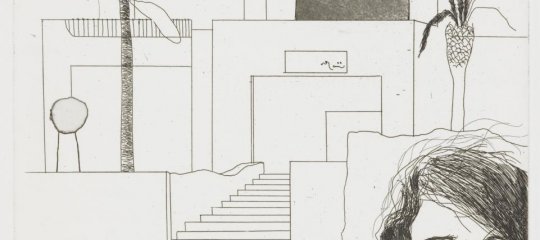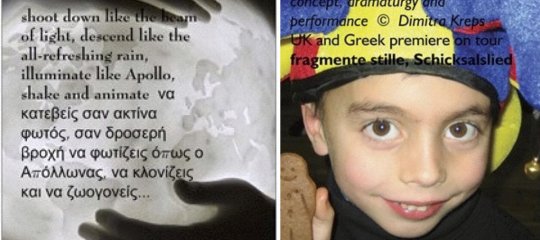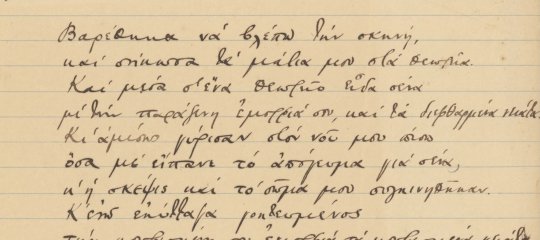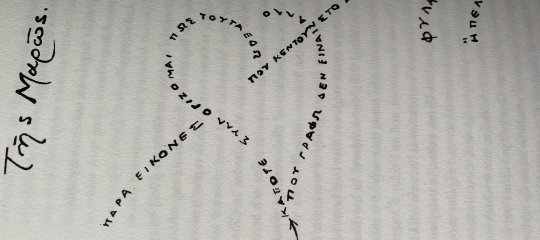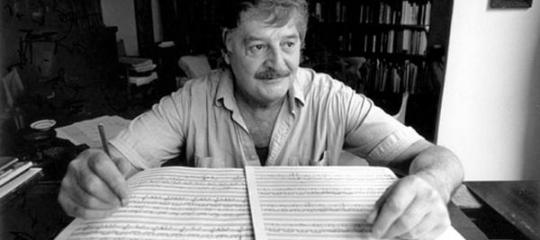Η Πέμπτη Ήπειρος
frantzkyr writes, "
Κυριακή Φραντζή
Peter Sculthorpe.Aυστραλός τασμανικής καταγωγής, από τους πιο αναγνωρισμένους συνθέτες κλασικής μουσικής που διαθέτει σήμερα η Αυστραλία. Το έργο του «Η Πέμπτη Ήπειρος», βασισμένο στο έργο του Άγγλου συγγραφέα Ντέιβιντ Χ. Λώρενς «Καγκουρώ» που γράφτηκε κατά την επίσκεψη του τελευταίου στην Aυστραλία το 1922, μεταδόθηκε για πρώτη φορά από το ραδιοφωνικό πρόγραμμα ABC το 1963 με αφηγητή και προμαγνητοφωνημένο ήχο, και έχει αλλάξει διάφορες μορφές μέσα στο χρόνο παραμένοντας πάντα επίκαιρο."
18 Ιουνίου 2007
Η ιδιοτυπία του έγκειται στο ότι, παρότι κλασικό έργο, περιλαμβάνει το γνωστό όργανο των ιθαγενών της Αυστραλίας ντιτζεριντού και προλογίζεται συχνά στις εκτελέσεις του από τη μελωδία τους Ντζίλιλε(κατά λέξη: πάπια που σφυρίζει σε μια λιμνούλα). Για το έργο αυτό, το 1970 ο συνθέτης δέχτηκε θερμό ευχαριστήριο γράμμα από τον ποιητή Ουτζερού της φυλής Νούνακαλ για την συμβολή του στην ευαισθητοποίηση της κοινής γνώμης των μη - ιθαγενών Αυστραλών σχετικά με τον πολιτισμό των πρώτων κατοίκων της χώρας. Η πιο πρόσφατη εκτέλεσή του έργου για σόλο βιολί, σόλο τσέλο, άρπα, τρομπέτα, όμποε και ντιτζεριντού από τη Συμφωνική Ορχήστρα της Τασμανίας με αφηγητή τον ίδιο το Sculthorpe περιλαμβάνει πέντε μέρη.
Το κείμενο του Ντ.Χ.Λώρενς που προλογίζει καθένα από αυτά τα μέρη μετέφρασαν στα ελληνικά οι φοιτητές του μαθήματος των προχωρημένων της γλώσσας Β΄ Ελευθερία Δάκη, Χρήστος Δαλαβίκας, Μαρία Clare και Νατάσα Χουρδά. Διευκρινίζεται ότι πρόκειται για μεταφραστικό γύμνασμα που έδωσε παράλληλα την ευκαιρία να συζητηθεί η ιδιαιτερότητα της λογοτεχνικής μετάφρασης. Ο πίνακας που τη συνοδεύει είναι έργο του Ελληνοαυστραλού ζωγράφου Τζιμ Θαλασσούδη. Στο τέλος παρατίθεται το πρωτότυπο του Λώρενς με πληροφορίες για το ίδιο το έργο του. Η εντύπωσή μου είναι ότι πρόκειται για ένα πολύ ενδιαφέρον βιβλίο.
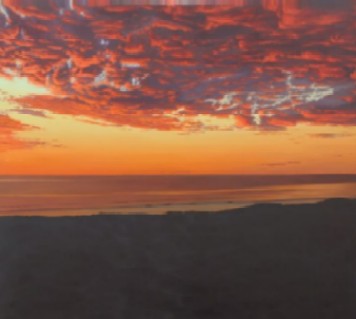
Jim Thalassoudis, A fine day tomorrow
Peter Sculthorpe: Η Πέμπτη Ήπειρος
Aπό το έργο του Ντέιβιντ X. Λώρενς «Καγκουρώ» (απόσπασμα)
Ι. Πρόλογος
Ο κόσμος στριφογύριζε και στριφογύριζε ώσπου εξαφανίστηκε. Όπως μια πέτρα πέφτει και ταράζει το νερό, έτσι και η παλιά του ζωή, το παλιό νόημα έπεσε και κυμάτισε, και μετά έγινε κενό με τη θάλασσα μέσα του και την ακτή της Αυστραλίας. Μακριά, πολύ μακριά, λες και είχε προσγειωθεί σε άλλο πλανήτη...
Γιατί είχε έρθει;… Γιατί;… Είχε καταλήξει στο συμπέρασμα πως όλα χάθηκαν, παίχτηκαν, τελείωσαν και πως πρέπει να πάει σε μια καινούρια χώρα. Στη πιο καινούρια χώρα από όλες: στη νεαρή Αυστραλία.
II. Οι απομονωμένες περιοχές της Αυστραλίας
Η απέραντη ακατοίκητη περιοχή τον φόβισε. Του φάνηκε τόσο αρχαϊκή και χαμένη, τόσο απρόσιτη. Ο ουρανός ήταν καθαρός, κρυστάλλινος καθαρός και γαλάζιος. Ο αέρας ήταν θαυμάσιος, φρέσκος και δεν τον είχε αναπνεύσει κανείς: και υπήρχαν μεγάλες αποστάσεις.
Αλλά το δάσος, το γκρίζο, καμένο δάσος... Ήταν σα φάντασμα, ένα ομοίωμα, με τα ψηλά χλωμά δέντρα του, και πολλά νεκρά δέντρα σαν πτώματα, μισοκαμένα απο τις πυρκαγιές... και ύστερα η φυλλωσιά τους ήταν τόσο σκοτεινή σαν γκριζοπράσινο σίδερο... Περιμένοντας, περιμένοντας - το δάσος φαινόταν να να περίμενε για πολύ καιρό.
Και δεν μπορούσε να διεισδύσει στο μυστικό του...Δεν ήταν ευτυχισμένος, δεν μπορούσε να προσποιηθεί πως ήταν ευτυχισμένος. Λαχταρούσε την Ευρώπη με μια πεινασμένη νοσταλγία...
ΙΙΙ. Mικρή πολιτεία
Ήταν μια θαυμάσια κεντρική Οδός, και ...πέρα από τον αγέρα. Υπήρχαν μερικά μεγάλα αλλά μάλλον τρομαχτικά καφετί ξενοδοχεία, με μπαλκόνια ολόγυρα: υπήρχε μια εκκλησία σοβαντισμένη κίτρινο με κωδωνοστάσιο σκεπασμένο με κόκκινη λαμαρίνα, σαν ένα αλλόκοτο παιχνίδι: υπήρχαν ...ψηλές σκεπές, όλες φτιαγμένες από αυλακωτό σίδερο: κι έφτανες σε ένα άνοιγμα και εκεί....ήταν ένα η δυο εγκαταλειμένες μονώροφες βίλλες με βεράντες μέσα στους ξύλινους φράκτες τους, και μετά το κενό.
...το μνημείο για τους νεκρούς στρατιώτες...είχε για επιγραφή «Πάντα στην μνήμη μας». Χαραγμένη στο κάτω σκαλοπάτι έλεγε: «Τα αποκαλυπτήρια έγιναν από την Γκράννυ Ράις». Ένα πραγματικό μνημείο της πόλης με τα ονόματα όλων – των πεσόντων, όλων εκείνων που φόρεσαν το χακί, εκείνων που έκαναν τα αποκαλυπτήρια και της Γκράννυ Ράις.
IV. Ειρηνικός
...Η ακτή ήταν η μεγαλύτερη του παρηγοριά...Τα τεράστια άσπρα κύματα του Ειρηνικού που έσπαζαν, σε ένα λευκό, μαλακό, σαν χιονισμένο τείχος, ο λευκός αφρός που επέστρεφε πίσω στην θάλασσα σαν χαίτη χτενισμένη, χτενισμένη ανάστροφα από το δυνατό, παγωμένο άνεμο...
Να είσαι μόνος, χωρίς μυαλό, χωρίς καμία ανάμνηση, να στέκεσαι ανάμεσα στη θάλασσα, κάτω απ το μελαγχολικό τοίχωμα της ακτής της Αυστραλίας.
Να είσαι μόνος πάνω σε μια μακριά πλατιά ακτή και γη, χωρίς καρδιά, χωρίς ψυχή.
Τόσο μόνος και απών και παρών όπως οι μαύρες ιθαγενείς σκιές στην άμμο, στον ήλιο…
Αυτό ήταν το ρεφραίν που έπαιζε συνέχεια στο βάθος του νου του. Ότι στέκεται άψυχος και μόνος δίπλα στο Nότιο Ωκεανό της Αυστραλίας.
ΙΙΙ. Επίλογος
Μερικούς μήνες αργότερα...Καθισμένος στην άκρη του δάσους κοίταζε τον οικισμό, και τη θάλασσα πέρα...
Την είχε κιόλας αγαπήσει. Αγάπησε αυτή την χώρα που εναντίον της είχε καταφερθεί τόσο μεγαλόφωνα.... Ενώ τον «ενδιέφερε», έπρεπε να στραφεί εναντίον της. Αλλά το ενδιαφέρον απ την στιγμή που έσπασε μέσα του, είχε γι αυτόν ένα βαθύ μυστήριο κι ένα σκοτεινό απόμακρο κάλεσμα που ήξερε ότι θα συνέχιζε να καλεί για αιώνες πριν βρει κάποια σωστή ανταπόκριση σε ανθρώπινα πλάσματα.
Το δάσος είχε ανθίσει, οι μιμόζες είχαν βγει...ήταν Αύγουστος και άνοιξη και καυτός, καυτός ήλιος σ έναν γαλάζιο ουρανό.
Peter Sculthorpe, The Fifth Continent
Εxtracts from "Kangaroo" by D.H. Lawrence
I. Prologue
The world revolved and revolved and disappeared. Like a stone that has fallen into the sea, his old life, the old meaning, fell, and rippled, and there was vacancy, with the sea and the Australian shore in it. Far off, far off, as if he has landed on another planet…
Why had he come?... Why?... He had made up his mind that everything was done for, played out, finished, and he must go to a new country. The newest country: young Australia.
II. Outback
…the vast uninhabited land frightened him. It seemed so hoary and lost, so unapproachable. The sky was pure, crystal pure and blue…the air was wonderful, new and unbreathed: and there were great distances.
But the bush, the grey, charred bush. It was so phantom –like, so ghostly, with its tall pale trees and many dead trees, like corpses, partly charred by bushfires: and then the foliage, so dark, like grey-green iron…Waiting, waiting-the bush seemed to be hoarily waiting And he could not penetrate into his secret. He was not happy, there was no pretending he was. He longed for Europe with hungry longing.
ΙΙΙ. Small town
It was a wonderful main Street; and …out of the wind. There were several large but rather scaring brown hotels, with balconies all round: there was a yellow stucco church with a red painted tin steeple, like a weird toy: there were high roofs and low roofs, all corrugated iron: and you came to an opening and there…were one or two forlorn bungalows inside their wooden palings, and then the void.
…the memorial to the fallen shoulders had ”Lest we forget” for a motto. Carved on the bottom step it said “Unveiled by Grannie Reis”. A real township monument, bearing the names of everyone possible: the fallen, all those who donned khaki, the people who presented it and Granny Reis.
IV. Pacific
The shore was his great solace…The huge white rollers of the Pacific breaking in a white soft, snow rushing wall, while the thin spume flew back to sea like a combed mane, combed back by the strong, cold- land wind...
To be alone, mindless and memoryless between the sea, under the sombre wall–front of Australia. To be alone with a long, wide shore and land, heartless, soulless. As alone and as absent and as present as an aboriginal dark on the sand in the sun…That was the perpetual refrain at the back of his mind. To be soulless and alone, by the Southern Ocean in Australia.
V. Epilogue
Some months later… Sitting at the edge of the bush he looked at the settlement, and the sea beyond…
Already he loved it. He loved the country he had railed at so loudly…While he “cared” he had to rail at it. But the care once broken inside him it had a deep mystery for him, and a dusky far-off call that he knew would go on calling for long ages before it got any adequate response, in human beings. The bush was in bloom, the wattles were out…it was August and spring and hot, hot sun in a blue sky.
Ο Ντέιβιντ Χέρμπερτ Ρίτσαρντ Λώρενς(1885-1930), πεζογράφος, ποιητής, θεατρικός συγγραφέας και ζωγράφος, διωχθείς λόγω παρερμηνείας των έργων του και αυτοεξόριστος από τη χώρα του μετά τον Α΄Παγκόσμιο Πόλεμο, πέρασε το δεύτερο μέρος της ζωής του ταξιδεύοντας σε πολλές ευρωπαϊκές χώρες, στην Κεϋλάνη, την Αυστραλία και τη Βόρεια Αμερική, στο πλαίσιο μιας περιπλάνησης που ο ίδιος είχε ονόμασει «άγριο προσκύνημα». Το 1922 μετά από σύντομη επίσκεψη στη Δυτική Αυστραλία έμεινε για τρεις μήνες στην παραλιακή κωμόπολη της Νέας Νότιας Ουαλίας Θίρρουλ όπου ολοκλήρωσε το μυθιστόρημα «Καγκουρώ». Στο έργο αυτό, όπου καταγράφονται και οι εμπειρίες του από την Κορνουάλη της εποχής του πολέμου, Καγκουρώ είναι το όνομα του αρχηγού μιας μυστικής φασιστικής παραστρατιωτικής οργάνωσης που απηχεί τη δράση στην Νέα Νότια Ουαλία μιας υπαρκτής παρακρατικής αστυνομίας που συστάθηκε για λόγους αντικομμουνιστικής προπαγάνδας από την κυβέρνηση Μπρους.
Το μυθιστόρημα «Καγκουρώ» υπήρξε πηγή έμπνευσης για το εθνοκεντρικό λογοτεχνικό κίνημα Τζιντιγουόρομπακ (Jindyworobak Movement) που αναπτύχθηκε στην Αυστραλία την περίοδο 1930-1950 και επιζητούσε να προωθήσει τις ιδέες και τα έθιμα των ιθαγενών κατοίκων της, ιδίως στην ποίηση, σαν τρόπο αντίστασης της τοπικής τέχνης απέναντι στην ξένη επίδραση. Tο 1986 μεταφέρθηκε στον κινηματογράφο με τον ίδιο τίτλο και με πρωταγωνίστρια τη γνωστή Αυστραλέζα ηθοποιό Τζούντυ Ντέιβις.
Πηγές
1. Peter Sculthorpe, The Fifth Continent, ΑΒC classics, 1997. Βλ. επίσης http://shop.abc.net.au/browse/product.asp?productid=380802
2. D.H. Lawrence, Kangaroo (1923) ed. by Bruce Steele, Cambridge University Press, 1994.
3. Jim Thalassoudis (γενν. Αδελαΐδα, 1962), A fine day tomorrow, από έκθεση Ελληνοαυστραλών ζωγράφων στην γκαλερί Woollahra Times, Ελληνικό Φεστιβάλ του Σύδνεϋ, 2007,http://www.felliamelas-timesart.com/main.asp?mode=artists
- Εισέλθετε στο σύστημα για να υποβάλετε σχόλια



